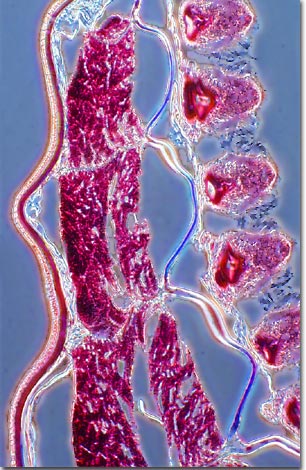Phase Contrast Image Gallery
Amphioxus (Lancelet)
Amphioxus, also called lancelet, is a small marine animal resembling a miniature fish without eyes (or even a head), which is found widely in coastal waters around warmer parts of the world. The photomicrograph below is a phase contrast image of an amphioxus stained thin section.

About 25 species have been identified of this small (about 3 inches long) eel-like creature, which is a member of the invertebrate subphylum Cephalochordata of the phylum Chordata. These invertebrates spend most of their time buried in the mud or sand in shallow waters of the ocean. Amphioxi feed by projecting the anterior portion of their bodies from the sandy ocean bottom to allow water to pass through their gill slits, which they use to filter food particles.
Amphioxi have a very poorly developed brain and sense organs, and also have no true vertebrae, which may explain their absence from the fossil record. The outward appearance of amphioxi is identical for males and females of the species, however the nature of the reproductive glands differs between the sexes. Eggs are fertilized in the warm, salty ocean water, and develop into fish-like larvae that are able to swim freely about.
Amphioxus is very abundant in certain parts of the world and can grow to populations exceeding five thousand per square meter of sand. The small invertebrate is useful in filtering water, especially in areas where they abound. Some societies harvest amphioxus commercially for food that is consumed both by humans and domestic animals.
BACK TO THE PHASE CONTRAST GALLERY
